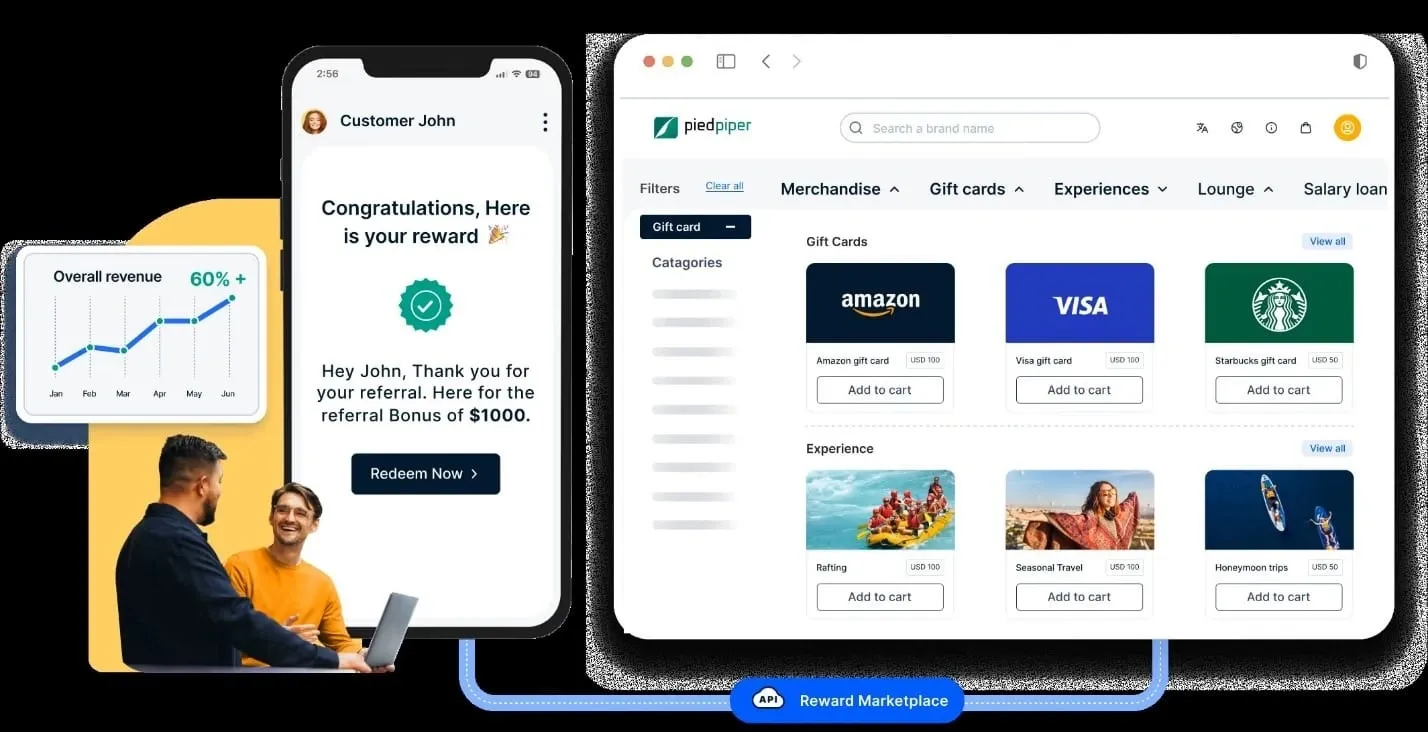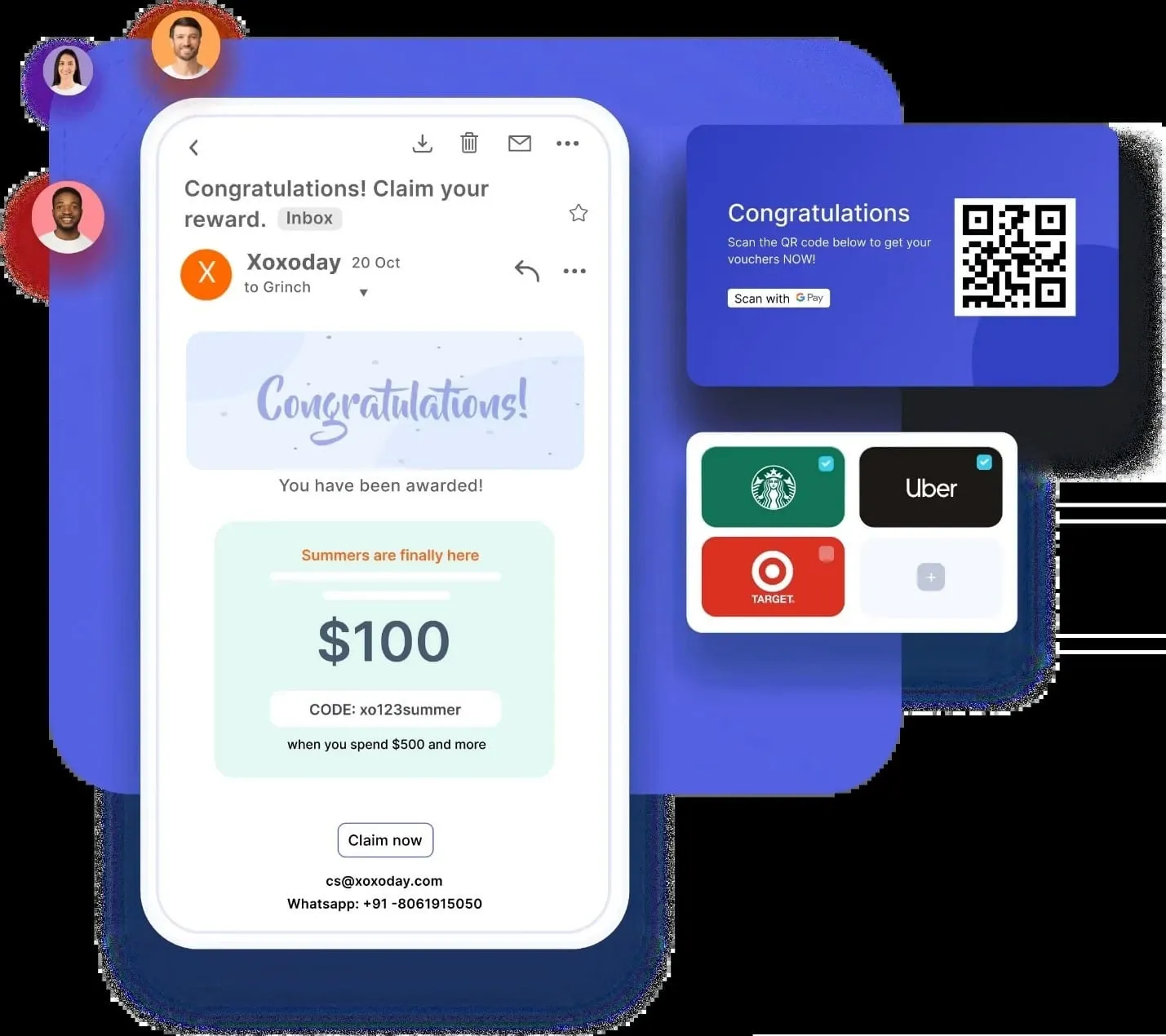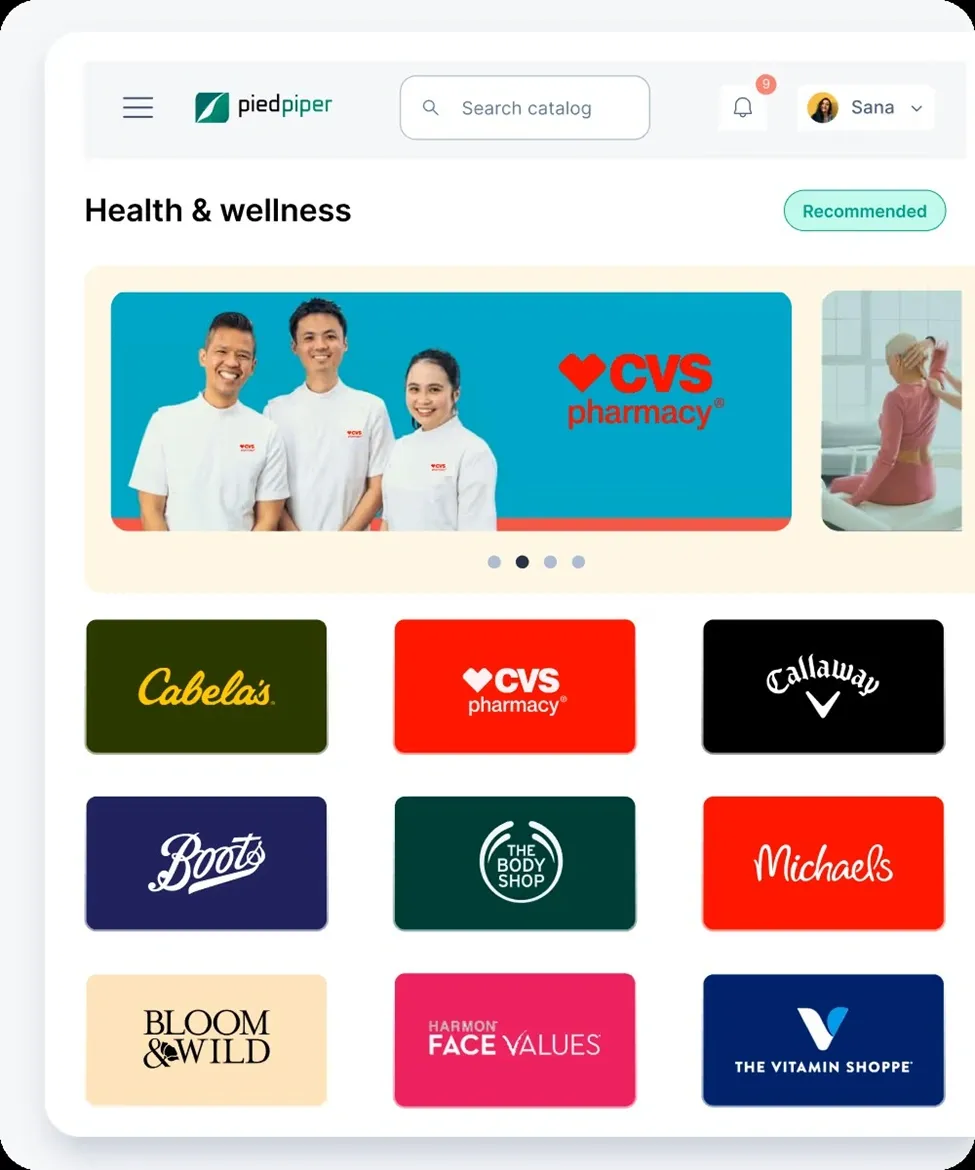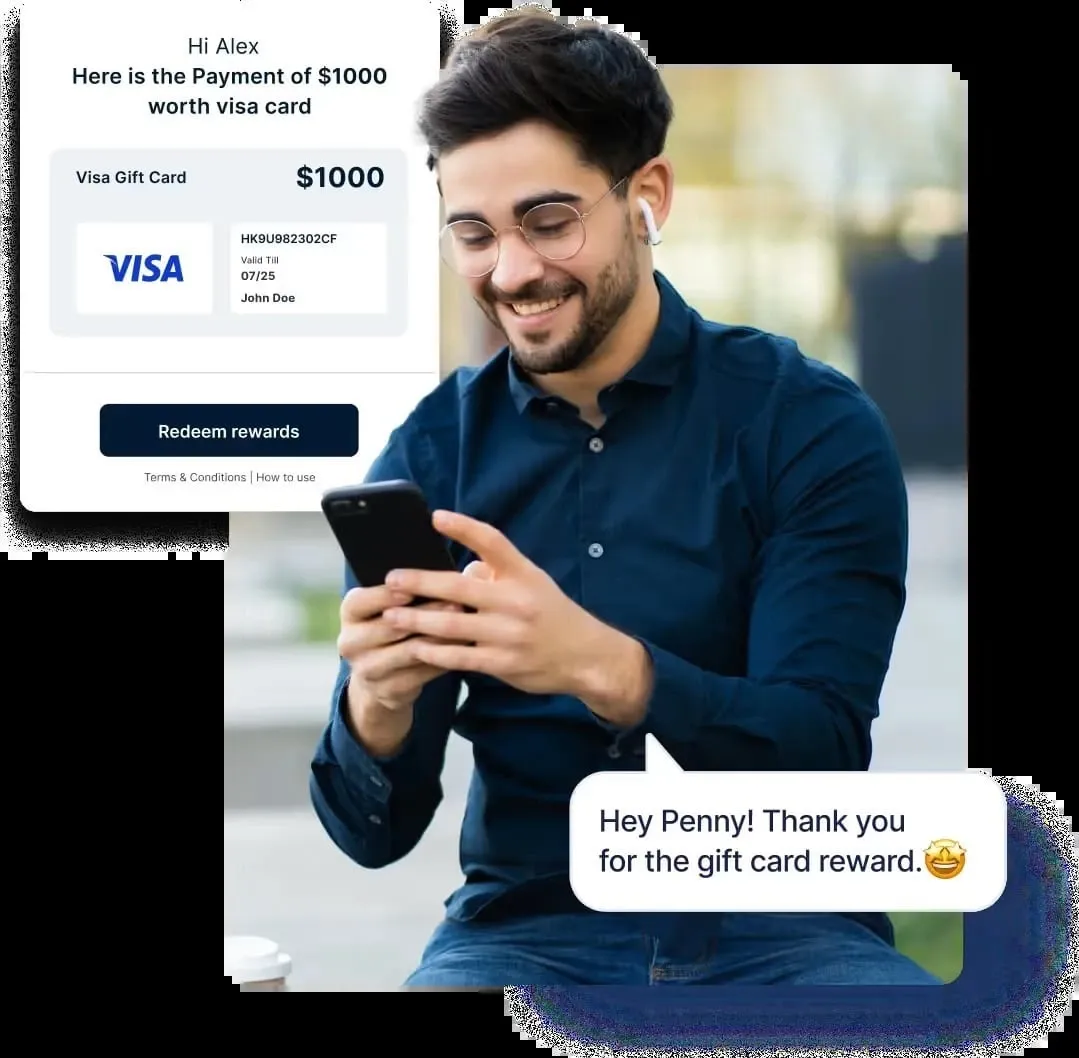المكافآت والحوافز للشركات الرقمية في العصر الحديث
تواجه الشركات الرقمية في العصر الرقمي الجديد ارتفاع تكاليف الاستحواذ، والاحتفاظ الزائل، وانخفاض المشاركة. تستكشف هذه المدونة كيف يمكن للمكافآت والحوافز الرقمية الاستراتيجية معالجة هذه التحديات، مع أمثلة حقيقية وأفكار من منظور فئوي ورؤى قابلة للتنفيذ.
في هذه الصفحة
- What are digital rewards and incentives?
- Challenges faced by new age digital companies
- How rewards & incentives can address the challenges of new-age digital companies
- What kind of digital rewards and incentives can be offered?
- How to choose the right digital incentives?
- Revamping employee recognition: H&M's partnership with Xoxoday
- استنتاج
The digital landscape constantly evolves, and the new-age digital companies are at the forefront. These companies, often born in the Internet and mobile technology era, are characterized by their innovative business models, data-driven approaches, and rapid growth trajectories.
They operate in a hyper-competitive environment where customer acquisition is expensive, retention is fleeting, and engagement is crucial for success.
Standing out in this crowded digital marketplace requires strategic and innovative approaches to attract new customers, keep existing ones engaged, and foster brand loyalty. In this context, rewards and incentives emerge as powerful tools to help new-age digital companies achieve their goals.
These companies can strategically offer rewards and incentives to motivate and encourage desired customer behaviors, drive engagement, and achieve a sustainable competitive advantage.
This blog post will explore the challenges faced by new-age digital companies and how rewards and incentives can be effectively utilized to address these challenges. It will also explore real-world examples of successful rewards and incentives implementations, look at real-world strategies for customer acquisition, retention, and engagement, and explore insights about the future of rewards and incentives in the digital age.
What are digital rewards and incentives?
Digital rewards are exactly what the name suggests—perks or incentives delivered digitally instead of in a physical form. The most widely used digital rewards are digital gift cards, which recipients can redeem online and use either at physical stores, restaurants, or on the brand’s website.
Virtual prepaid cards, such as Visa or MastercardⓇ, provide even greater flexibility since they can be used across various retailers, not just one.
Other forms of digital incentives include charitable donations, virtual event tickets, discount coupons, downloadable media, promo codes, gated content access, virtual achievement badges, and digital items like eBooks or premium articles.
What unites all these rewards is their ease of delivery—there’s no need for shipping or handling. They can be sent directly via email, SMS, or through a personalized link on your website or company portal.
Among all options, digital gift cards remain a top favorite for their flexibility and broad appeal, letting recipients choose their own reward from popular brands like Amazon, eBay, Walmart, Target, Wayfair, and more.
Challenges faced by new age digital companies
Here are the challenges faced by new-age digital companies:
1. High customer acquisition cost (CAC)
New-age digital companies constantly battle the rising cost of acquiring new users. Once considered reliable, traditional marketing and advertising channels are becoming increasingly saturated and expensive.
This is further compounded by:
- Blind bidding: Platforms like social media utilize auction systems, leading to fierce competition for user attention, with the highest bidder often winning ad space.
- Banner blindness: Users are becoming increasingly accustomed to ignoring online advertisements, rendering many traditional banner ads ineffective.
- Fraudulent clicks: The presence of fraudulent clicks and bot activity can inflate advertising costs without delivering genuine leads.
These factors contribute to a high Customer Acquisition Cost (CAC), making it crucial for new-age digital companies to find innovative and cost-effective ways to reach new customers.
2. Low user retention
Even after acquiring new users, the battle is far from over. New-age digital companies grapple with the challenge of low user retention. Several factors can contribute to user churn, including:
- Lack of differentiation: In a crowded digital marketplace, standing out requires a clear value proposition and differentiation from competitors. Users who perceive another company to offer a better product or service are likelier to switch.
- Competition: The constant influx of new players vying for user attention amplifies the retention challenge. Users have countless options, and companies must continuously strive to deliver exceptional value to retain their user base.
- Low perceived value: If users do not perceive the company's product or service as valuable enough to justify continued use, they are likelier to churn. This could be due to a lack of features, poor user experience, or unmet expectations.
Addressing these factors and engaging users to create value and attachment are essential for new-age digital companies to improve user retention and maximize customer lifetime value (LTV).
3. Low user engagement
Beyond simply acquiring and retaining users, fostering high levels of user engagement is crucial for new-age digital companies. However, this presents its own set of challenges:
- Short attention spans: In today's digital world, users have shorter attention spans and are easily distracted by competing apps, platforms, and content.
- Lack of purpose: If users don't see a clear purpose in using the platform or understand how it adds value to their lives, they are less likely to engage consistently.
- Complexity and friction: Complex user interfaces or cumbersome functionalities can deter users from engaging regularly.
4. Employee motivation
The fast-paced, high-growth environment characteristic of new-age digital companies also presents challenges related to employee motivation. Here are some key aspects to consider:
- Burnout and stress: The demanding nature of the work can lead to employee burnout and stress, negatively impacting productivity and overall well-being.
- Skills gap: As companies rapidly evolve and adopt new technologies, the risk of a skills gap emerges, requiring ongoing employee training and development to maintain motivation and engagement.
- High employee turnover: In a competitive talent market, high employee turnover can be disruptive and lead to a loss of valuable institutional knowledge.
How rewards & incentives can address the challenges of new-age digital companies
In the cutthroat world of new-age digital businesses, where competition is fierce and user attention fleeting, attracting new customers, retaining existing ones, and fostering engagement is paramount.
But achieving these goals can be an uphill battle. This is where rewards and incentives come in, crucial in addressing the key challenges these companies face.
1. Customer acquisition
- Account-Based Marketing (ABM): It is a game-changer for customer acquisition. Unlike traditional methods that scatter a wide net, ABM focuses on a targeted list of high-value companies.
This focus allows for deep research and personalized messaging directly addressing each account's unique needs and challenges. By crafting content and rewards that resonates and building relationships with key decision-makers, ABM dramatically increases the chance of converting these ideal customers.
- Referral programs: Referral programs incentivize existing users to spread the word about your product or service by offering them rewards like discounts, points, or exclusive benefits for successful referrals. This leverages the power of word-of-mouth marketing and can significantly reduce customer acquisition costs (CAC). Over 9 in 10 consumers trust referrals from friends and family over anything else

- Welcome bonuses and trial periods: First impressions matter and offering welcome bonuses or free trials can be a great way to entice new users. These incentives act as a low-risk entry point for potential customers, allowing them to experience your offering firsthand before committing financially.
- Gamification: Implementing gamification elements like points, badges, and leaderboards can increase user engagement and serve as a subtle acquisition tool. These elements add a layer of fun and competition, encouraging users to take desired actions, ultimately leading to higher conversion rates. Gamification companies can see up to 7X higher conversion rates.
2. الاحتفاظ بالعملاء
- Loyalty programs: Loyalty programs reward repeat customers for their continued patronage, creating a sense of value and appreciation. These programs can offer various benefits like points redeemable for rewards, exclusive discounts, or priority access to new features. According to 69% of consumers, loyalty programs influence their purchasing decisions.
- Tiered benefits: Take loyalty programs to the next level by introducing tiers with increasing benefits. As users engage more and climb the tiers, they unlock enhanced rewards and exclusive perks, further incentivizing them to remain active and loyal.
- Personalized rewards: Not all customers are created equal. Tailoring rewards to individual user preferences can significantly enhance the impact of your program. By leveraging data-driven insights on user behavior and preferences, you can offer personalized rewards that resonate with each user, making them feel valued and appreciated.

3. User engagement
- Points and rewards for actions: Encourage users to actively engage with your platform by rewarding them for specific actions. This could include completing tasks, purchasing, sharing content, or participating in discussions. By associating rewards with desired behaviors, you can nudge users towards more active engagement, ultimately increasing user lifetime value (LTV).
- Contests and giveaways: Inject some excitement and spark user participation through contests and giveaways. Offer attractive prizes like free products, exclusive experiences, or early access to new features. These events create a sense of buzz and encourage users to compete and interact, boosting overall engagement with your platform.
- Early access and exclusive offers: Make users feel special and valued by offering them early access to new features, exclusive discounts, or limited-edition products. This incentivizes engagement and fosters a sense of community and exclusivity, strengthening the bond between users and your brand.
4. Employee motivation
- Performance-based rewards: Recognize and reward employees for their achievements and contributions. Implementing performance-based rewards like bonuses, commissions, or public recognition can significantly boost employee motivation and drive them to strive for excellence consistently.
- Social recognition and awards: Publicly acknowledge and celebrate employee achievements through awards programs or shout-outs. This motivates the recognized individual and inspires others to excel, fostering a strong sense of teamwork and collaboration.
- Employee wellness programs: Prioritize your employees' well-being by offering wellness programs that focus on their physical and mental health. These programs can include gym memberships, mental health resources, or flexible work arrangements. Investing in their well-being creates a supportive and positive work environment, ultimately leading to increased employee motivation and satisfaction.

What kind of digital rewards and incentives can be offered?
Digital rewards can be grouped into categories that cater to various recipient preferences, from shopping and wellness to entertainment and social impact. Here's a breakdown of popular categories and top reward options within each:
Gift cards
These are flexible, universally appreciated rewards that allow recipients to choose what they want. They're ideal for personalizing the experience without overcomplicating the selection process.
- Amazon e-gift card – Ideal for shopping across a wide range of categories.
- Starbucks gift card – A perfect pick-me-up for coffee lovers.
Prepaid & wallet cards
Prepaid cards and wallet credits offer the freedom to spend on almost anything, making them a versatile reward. They’re convenient and widely accepted online and offline.
- Visa/MastercardⓇ virtual prepaid cards – Usable across online and offline stores.
- Paytm or PhonePe wallet credits – Convenient for mobile payments and everyday purchases.

E-commerce & retail rewards
Perfect for rewarding consumers or employees who enjoy online shopping. These rewards offer access to a variety of categories like fashion, electronics, and home goods.
- E-gift card – Great for everything from gadgets to groceries.
Wellness & lifestyle
Support the well-being of recipients with rewards that promote physical and mental health. These are great for encouraging self-care and healthier lifestyles.
- Fitness/gym subscription – For fitness classes, therapy, and overall wellness.
- Calm or headspace membership – For guided meditation and mental health support.
Entertainment & dining
Great for leisure-focused rewards, this category allows recipients to enjoy meals or relax with music and streaming content. A perfect way to enhance work-life balance.
- Spotify Premium gift card – Stream music without ads.
Charity & Purpose-Driven Rewards
These rewards help recipients contribute to meaningful causes, adding emotional value to the gifting experience. Ideal for brands that prioritize sustainability and social impact.
- Donation to a cause (e.g., education, health, environment) – Supports meaningful initiatives.
- Tree plantation in recipient’s name – A green and memorable gesture.

Learning & development
Fuel growth and curiosity with access to online learning platforms. These rewards help individuals upskill and invest in their personal and professional development.
- Udemy or Coursera gift card – Access thousands of online courses.
- LinkedIn learning subscription – Learn in-demand skills on the go.
How to choose the right digital incentives?
Choosing the right digital incentives involves understanding your audience, your goals, and the context in which the reward is being given. Here’s a practical framework to help you make the right choice:
1. تعرف على جمهورك
Understanding your recipients is the first step. What motivates a millennial employee may not appeal to a senior executive or a B2B customer. Consider factors like age, location, job role, lifestyle, and preferences. The more relevant the reward, the more likely it is to be appreciated and redeemed.
2. Match the incentive to the goal
Every reward should align with the outcome you're aiming for. Are you trying to increase survey participation, boost employee morale, or improve customer retention? Tailor the incentive accordingly quick wins like gift cards work well for feedback, while long-term loyalty may call for experience-based or tiered rewards.
3. Offer choice and flexibility
One size doesn't fit all. Offering multiple reward options gives recipients the freedom to choose something they truly value. Multi-brand gift cards, digital marketplaces, or customizable reward links help maximize satisfaction and minimize the chances of rewards going unclaimed.
4. Ensure instant delivery and accessibility
Digital incentives should be easy to send and even easier to redeem. Look for rewards that can be delivered instantly via email, SMS, or link—especially for global recipients. Timely delivery ensures that the reward remains relevant and enhances the overall experience.
5. Stay within budget without sacrificing appeal
A good incentive doesn’t have to break the bank. Focus on perceived value—some low-cost digital rewards like premium content, subscriptions, or discount codes can be very effective. Set clear budgets and choose platforms that offer transparent pricing and tracking tools.
6. Align with brand values
Rewards should reflect your company’s identity and values. For example, if your brand emphasizes sustainability, offer green rewards like tree-planting donations or eco-friendly products. This strengthens brand recall and makes your gifting strategy more authentic and meaningful.
Revamping employee recognition: H&M's partnership with Xoxoday
H&M, a leading global fashion retailer with over 171,000 employees worldwide, is renowned for offering fashion and quality at the best price in a sustainable way. With operations spanning more than 73 locations and encompassing nine independent brands, H&M continually seeks innovative solutions to enhance its human resource initiatives and maintain a motivated workforce.
Challenges faced:
H&M's internally developed Human Resource Management System (HRMS) faced several challenges in effectively implementing employee rewards:
- Cash-based rewards: Employees received rewards in cash alongside their salaries, which were subject to a flat tax rate, reducing the actual reward value.
- Logistical complications: Coordinating reward distribution involved multiple teams, including salary processing, winners, and HR business partners, making the process cumbersome.
- Diminished value for on-site employees: For on-site employees, currency conversion rates and applicable taxes further decreased the reward's value, leading to dissatisfaction.
Solution by Xoxoday Plum:
To address these challenges, H&M implemented Xoxoday's points-based rewarding system, offering multiple reward options such as experiences, gift vouchers, and perks. This integration provided:
- Enhanced rewarding efficiency: Streamlined processes reduced interdepartmental coordination, leading to a significant increase in peer-to-peer and manager nominations.
- Simplified on-site rewarding: On-site employees could easily redeem localized rewards tailored to their interests and geographic location, enhancing participation.
- Tax-efficient rewards: Employees received the full reward value without flat tax deductions, ensuring the incentives were more meaningful.
النتائج
The implementation of Xoxoday's solution yielded remarkable outcomes:
- Increased participation: 52% of all employees were nominated in the last fiscal year, with 10% receiving awards, indicating heightened engagement.
- Positive employee feedback: Surveys revealed a majority of employees favored the new rewarding process, appreciating its simplicity and effectiveness.
- Operational efficiency: The HR team experienced reduced administrative burdens, allowing them to focus on other strategic initiatives.
By partnering with Xoxoday, H&M successfully transformed its employee rewards and recognition program, fostering a more engaged and motivated workforce.
استنتاج
The digital age hasn’t just changed how we work or shop—it’s rewired how people respond to value. Static rewards and one-size-fits-all perks don’t cut it anymore. What moves the needle today?
Thoughtfully timed, context-driven incentives that feel less like transactions and more like appreciation. In this new landscape, strategic rewards are no longer perks—they’re signals of respect, recognition, and relevance.
Xoxoday Plum makes this process seamless by automating the entire rewards journey—from selection to delivery. Whether you're incentivizing customers, recognizing employees, or delighting partners, Plum offers a global catalog of digital rewards, effortless integration with your existing tools, and detailed insights to optimize performance. Its flexibility, personalization, and scalability make it the go-to platform for modern businesses.
Ready to turn motivation into momentum?
Book a free demo with Xoxoday Plum today and build a rewards strategy that drives impact where it matters most.


















